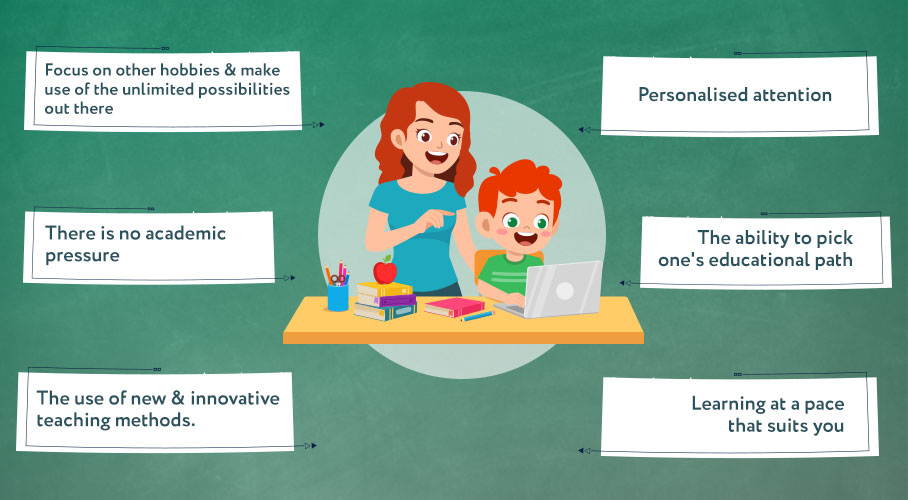In 2020-2021, the United States had around 3.7 million homeschool students in grades K-12 (roughly 6 to 7 percent of school-age children). In spring 2019, there were approximately 2.5 million homeschool pupils (around 3% to 4% of school-aged children) [note 1]. The homeschool population has been expanding between 2% to 8% per year for several years, but it increased dramatically between 2019-2020 and 2020-2021.
In India, homeschooling is also gaining traction and has grown more formalized and competitive, with agencies providing the resources necessary to succeed. Homeschooling is developed in India for children with specific needs who require more significant family assistance. However, as worries about a rigorous educational system arose, many parents experimented with the notion. The COVID-19 outbreak rekindled parents’ enthusiasm for homeschooling. Thus, it would not be inaccurate to assert that homeschooling is growing gradually but steadily in India. Following the epidemic, the numbers are expected to increase even further soon.
Learning new things and developing existing abilities and interests are the hallmarks of any educational system. Every academic style, even homeschooling, has advantages and disadvantages, affecting a child’s future positively and negatively.
Let’s understand this better:
Homeschooling: What Is It?
The term “homeschooling” refers to teaching children at home rather than in a traditional classroom setting. A more informal curriculum is commonly used by parents who opt to homeschool their children. They use everyday life, nature, and travel to teach their children. There is, however, more to it than that. The transition to homeschooling is a significant one.
It is common for parents to homeschool their children when they are dissatisfied with the way their children are taught in the public school system. Many parents choose to homeschool their children to instill a particular set of moral or religious values in them or shield them from racism, bullying, and other forms of discrimination. Parents may choose to homeschool their children to spend more time on non-academic pursuits, such as sports, music, or other activities.
According to Holt, author of the best-selling book Teach Your Own, the most critical component of homeschooling is “to admire them, to take pleasure in their company, their physical presence, their vitality, folly, and enthusiasm. They must take pleasure in all their conversation and inquiries, as well as taking pleasure in attempting to answer those questions.” Most parents who homeschool require merely a desire to do so and a commitment to the educational process.
But how do you know when to start and what are your child’s chances of success from homeschooling?
What Are the Benefits of Homeschooling for Children?

1. The use of new and innovative teaching methods.
When a child is homeschooled, parents can experiment with new teaching methods. Throughout the day, parents may take advantage of ‘teachable moments, such as nature walks, market trips, museum visits, online games, and podcasts, as well as roleplaying with their children. A homeschooling family has the freedom to pick learning methods depending on the kid’s interests – going as far into the subject as they like.
2. There is no academic pressure
Parents can choose a learning timetable for their children because there is no preset curriculum to follow or exam to offer in homeschooling. Having less burden on a child’s mental and emotional well-being makes studying more enjoyable.
Every child is unique, and homeschooling respects this. There are times when a teacher can’t personalize a lesson to each student’s specific learning goals and learning style in a typical school setting with a big group of pupils and one teacher.
3. Personalised attention
Homeschooling parents may, on the other hand, tailor classes to the specific interests of their students. The parents can accommodate each child’s learning style or degree of experience.
4. The ability to pick one’s educational path
There are many options for a child’s education while they are homeschooled. Homeschooling allows parents to experiment with a wide variety of workbooks, curricula, and teaching methods since it is so flexible. They may then pick and choose the ones that work best for each youngster.
5. Learning at a pace that suits you
When students are forced to work at a speed they are not used to, they often feel dissatisfied. Repetitive reviews and additional practice sheets might tire children of uncomplicated concepts. When they are unable to keep up with their peers, they might become frustrated.
Using homeschooling, a youngster may take their time with challenging courses and hurry quickly with easier ones. As a result of going at their speed, pupils who are homeschooled can learn more than they would in a traditional classroom.
6. Focus on other hobbies and make use of the unlimited possibilities out there
Learning may take place in any location and at any speed with homeschooling. They have more time for extracurricular activities like music, art, and athletics, typically overlooked in traditional schools.
In What Ways is Homeschooling Disadvantageous?
1. Parents may be under even more stress
Parents who homeschool their children feel the weight of responsibility. To devote the time and attention that homeschooling demands, they may have to give up some of their job ambitions.
2. The pupil may feel solitary.
Children who are schooled at home are deprived of the chance to interact with peers from a diverse range of socioeconomic backgrounds. Because of this, individuals may feel alone and separated from their peers. When it comes to homeschooling, this is one of its most significant drawbacks.
3. Being judged for all actions.
Suppose other parents don’t comprehend the notion. Because homeschooling is a relatively new phenomenon, other parents may be unfamiliar with it. Often, parents who choose to homeschool their children face criticism from the public, questioning whether their children are learning.
4. Limitations imposed by parents
To teach effectively, teachers must endure years of training. Parents may lack the ability to teach their children because they lack the knowledge, patience, or expertise. There will be days when they cannot provide their full attention to the children, making learning more difficult.
5. A lack of social abilities
Homeschooled students do not receive the same education in dispute resolution and negotiation as in public schools. In addition, their perspectives on the world and methods of coping are constrained.
6. The absence of facilities for student enrichment (library, lab, art studio)
As a traditional educational system, schools have state-of-the-art computer laboratories, science labs, gymnasia, swimming pools, and libraries and art centers. On the other hand, Homeschooled children do not have access to such facilities – a crucial component of a complete education.
7. Universities may not recognize your homeschooling experience
Despite this, many schools, universities, and government agencies do not consider homeschooling an acceptable educational option for students. Students who apply to college must submit a copy of their high school diploma; these disadvantages homeschooling children.
Conclusion:
A family’s decision to homeschool or send their children to public school is a matter of personal preference. When it comes to deciding between the two, online learning is a beautiful alternative if you aren’t sure which one to go with. Teachers that are certified to instruct your pupils can be found at schools that provide online learning. Because online courses allow students to work together on assignments and projects, they offer them the chance to stay in touch with their classmates at all times. Learning boards and institutions throughout the world have also embraced online education. Pupils can unlearn without being inhibited because of online learning.

